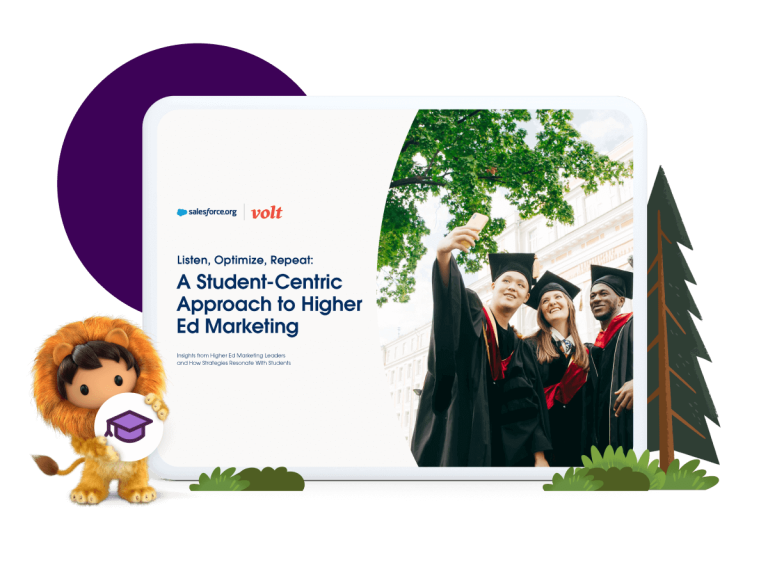With an ever-shrinking pool of new enrollments, colleges and universities must stand out from the crowd to attract the right students in their recruitment efforts. Higher education marketing is more important than ever. But what tactics work the best?
One which stands the test of time is email. According to Salesforce’s Eighth State of Marketing report, outbound email increased 15% between 2021 and 2022, remaining the preferred channel for consumers to interact with brands. To best reach prospects, institutions should focus on the latest trends in email marketing.
Trends in higher ed email marketing
With so much of today’s communication happening digitally, it might seem challenging to connect with prospective students on a personal level. But some recent trends in email marketing for higher education combine technology with in-person interactions — through data and insights — to segment, personalize, and spotlight opportunities for authentic connections.
- Emphasize institutional values and social stances: Prospective students want to know if a university shares the same values they do — and with dropping enrollment rates and stiff competition, showcasing your institution’s mission and values is more important than ever. Two in three students on college campuses care about social justice issues, according to a 2021 survey from Best Colleges. Additionally, more than 50% of students said their interest in these issues impacted the selection of their coursework. Universities should take the time to hone in on their brand and authentically spotlight it in their email marketing campaigns.
“One of the best ways you can influence people is the brand piece,” says Kate Ledger, Assistant Vice Chancellor of Marketing at the University of Pittsburgh, in A Student-Centric Approach to Higher Ed Marketing. “If you do it right, if it’s rooted in truth, everyone buys into it, and everybody wants to be part of that telling the story.”
- Optimize in-person insights: Though it may seem counterintuitive, according to students surveyed in Salesforce’s A Student-Centric Approach to Higher Ed Marketing report, interactions with admission counselors are far more influential than a university’s social media during the recruitment process. Prospective students value personal interactions, especially with staff who understand their unique needs. So, where does this fit into email marketing? Personal interactions during the prospect journey can provide valuable insights into a student’s decision-making process. If those insights can be recorded to a single source of truth, universities can use that information to better target prospective students in future email recruitment campaigns.
- Personalized messaging matters: Today, universities must operate like companies to attract and retain students in a highly competitive market. More than 70% of customers expect companies to understand their unique needs and expectations, according to Salesforce’s 2022 State of the Connected Customer report. The same can be said for prospective students (i.e. the customer). Universities want to spend resources targeting prospects who would thrive in their environment and ultimately, complete their degrees. Collecting data, creating personas, and segmenting those personas for personalized messaging in email marketing is vital.

Report
Adopting a Student-Centric Approach to Higher Ed Marketing
Gain insights about the new higher ed marketing landscape and strategies to create a student-centric vision.
6 steps to effective higher education email marketing
Now that you understand the trends, let’s analyze how to incorporate them into your university email marketing efforts.
1. Build a strong email list.
Before you can create a winning higher ed email marketing campaign, you need email addresses — and a lot of them.
Traditional tactics include collecting emails at college fairs, in-person campus visits, or from a prospect signing up for a newsletter. Be sure you gain permission to add student names to your lists, not only for legal reasons but also to better target prospects who are actually interested in learning about your school.
You can also incentivize students to boost the number of emails collected by:
- Offering downloadable content, such as detailed academic program brochures or the latest digital edition of the university magazine, in exchange for the prospect’s email address.
- Including a fully-automated scheduling tool on your website for prospects to provide their email address to confirm a call with a recruitment officer or academic advisor.
When you send that first email, be sure to include a drop-down field where prospects can select what they’re most interested in learning more about. Perhaps a sports program is at the top of their list, or the journalism department piques their interest. This information can help you segment prospects further into future email nurture campaigns.
2. Segment for success.
Segmenting your audience is one of the golden rules of email marketing best practices. Segmentation is essentially splitting your email list into targeted audience groups or personas. Examples of these personas for higher education include:
- Academic areas of interest
- Extracurricular activities
- Age demographics
- Behavior demographics
- Location-based
- Where they are in the enrollment journey (top, middle, or bottom of the funnel)
The best way to segment is by using a customer relationship management system (CRM) for schools that can automatically build and segment lists for you. Take it further by pairing your CRM with marketing software to manage and analyze interactions and data throughout the enrollment journey. Personalization will play a key role in turning prospective students into enrolled ones.

Guide
The Higher Education Marketing Guide
See how to drive alignment and make your institution future-ready.
3. Put people and personalization at the forefront.
We live in a personally-curated world. From online ads to our music apps, personalization is no longer a nice feature — it’s an expectation from consumers. University email marketing is no different.
Building a personalized marketing strategy
Four out of five recently-enrolled students felt their selected college was either “not at all” or only “a little” interested in learning about their recruiting experience for the purpose of improvement, according to Salesforce’s A Student-Centric Approach to Higher Ed Marketing report. Institutions can send an automatic survey to recently-enrolled students to create better email marketing campaigns without much effort.
To be able to personalize emails like this, however, you need to start with accurate user journey data. User journeys map the timeline and key decision points for prospective students. At each of those points, you want to identify the student’s needs and deliver key messages to address them. Doing so can turn a potential student into an enrolled one. Prospect needs may include:
- Flexible class scheduling
- Proof of graduation outcomes
- Proof of affordability
- Support with childcare
- Reassurance of institutional value alignment
- Access to a student-work program
But it’s not enough just to understand your prospects’ needs. You must capitalize on the appropriate time to deliver messaging around those needs. A CRM that captures holistic information is the best tool to accomplish this.
Look for a CRM that:
- Unifies data into a single source. The number one goal of recruiting in email marketing is targeting the right prospects. Use current student data to help you form a better overall picture of your school’s ideal student. A CRM that integrates data across departments to provide a holistic view of students can help higher education marketing teams create more tailored prospect emails. This was the case for Lebanon Valley College, which switched to a CRM with cross-department integration. The data they gathered allowed them to build better personas and target the ideal prospect during the recruitment process, helping them hit record first-year student enrollment numbers in 2019.
- Ability to integrate a marketing platform. When your CRM and marketing platform are integrated and synced, your campaigns will deliver the best results. Your CRM pulls in valuable personal data while your marketing platform delivers and tracks emails across the user journey, helping you deliver key messaging at the appropriate time automatically.
Lead with people-centric emails
Showcasing the value of your school through graduation completion and average future-income stats can be effective in email marketing. This can be done by sharing first-person accounts from current students and alums to build authentic connections with your prospects. You could lead emails with:
- Embedded student video stories.
- Student social media posts from homecoming or other events.
- Alumni success stories using video or lots of images.
- Alumni engagement opportunities, including professional development events.

“We want to put our audiences first and we really want to dive into the data that guides our decisions so that we’re really using the data as a way to be a voice of our audiences and creating our communications to respond to their needs.”
– Jill Andrews, Chief Branding Officer at Arizona State University
4. Get help from automation and AI.
In today’s highly competitive education climate, everyone is looking for ways to reduce costs while improving sales — in this case, enrollment numbers. An email marketing campaign that uses automation and AI can augment personalized email campaigns through data-driven insights. This could relieve admissions officers of administrative work and give them more time to focus on nurturing end-of-funnel prospects. It’s no wonder more than 60% of marketers are investing in AI to meet the demand for personalized experiences.
Some automation capabilities that are useful for institutions include:
- Segmenting lists.
- Pre-scheduled email sends.
- Cross-department data collection for user journeys.
- Actionable insights.
Data from AI chatbot interactions can automatically be recorded to your CRM so your integrated marketing platform can gauge the next best steps in user journeys. For example, let’s say a prospect is curious about the affordability of your university and a chatbot provides a breakdown of how much they would likely pay out-of-pocket. With this information recorded, a trigger could be set in your marketing platform to send a follow-up email with scholarship opportunities that the prospect is qualified for, along with a call to action (CTA) to schedule a call with a financial advisor.

“Anything we can do to remove tasks, like manual email sends, helps us reduce our workload and lets us focus more on strategy rather than tactics.”
– Jamie Rowe, Director of Marketing at Lebanon Valley College
5. Make it mobile-friendly.
More than half of Americans spend at least 5 hours a day on their phones, according to Statista. Thus, optimizing your email content and design for mobile, desktop, and tablet is a necessity. You can make your emails even more mobile-friendly by:
- Striving for short, attention-grabbing email subject lines.
- Avoiding text-heavy emails — let images and videos convey the message.
- Being consistent with logo colors, voice, and tone that reflects your brand.
- Offering a clear CTA.
When prospects can seamlessly open and interact with your emails on any desktop or mobile device, they’re more likely to keep engaging with them during the recruitment process.
6. Don’t stop tracking and testing.
Tracking key performance indicators (KPIs) is vital to creating a great email campaign. Some important KPIs for email include unsubscribe rates and click-through rates. Are your Gen Z prospects opening video-based or social media-based emails at a higher rate? What kind of CTAs work better for prospects who are parents?
Automated A/B testing is another powerful analytics tool to help you determine a winning email marketing formula. Essentially, two versions of an email get sent to prospects. Elements that may differ between the two include subject lines, preheader text, CTA, design, or delivery timing. Tracking and analyzing the KPIs from automated A/B tests allow you to adjust tactics as needed to create data-driven email campaigns that deliver results without building a new campaign from the ground up.
Reach the right students with the right technology.
At the heart of great higher education email marketing is the ability to target prospects who align with the unique identity and offerings of your school. Finding the right students requires the right technology. You need tools that can help you collect data to create personas, track user journeys, and create personalized email marketing content.
Salesforce for Higher Education can help by giving you a 360-degree view of current students and prospects. When you can track and analyze your tailored email campaigns and use insights to adjust tactics along the way, you will be able to do more with less while still making a major impact.
